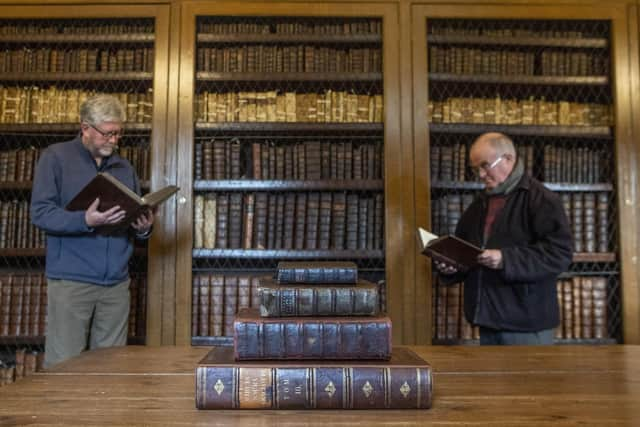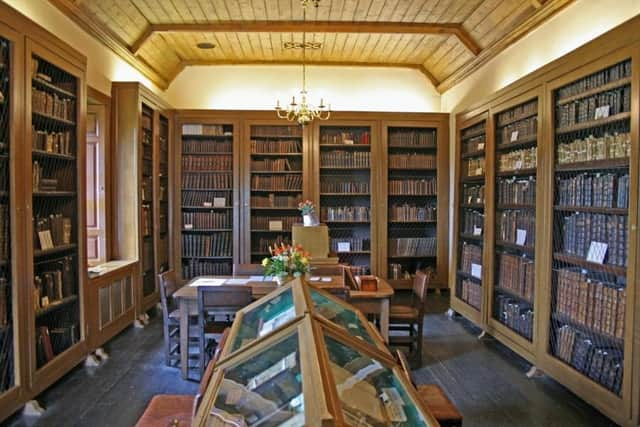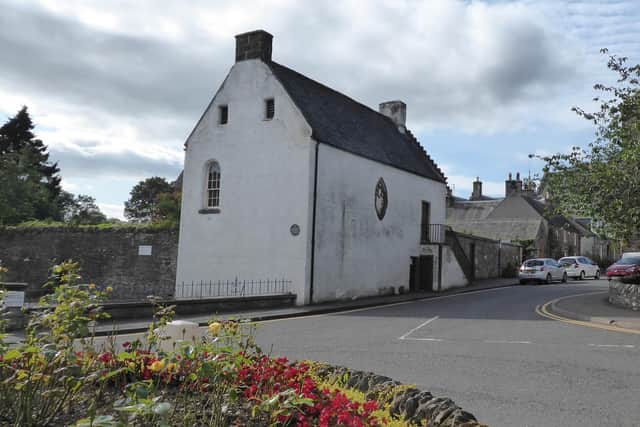Inside the tiny 'hidden treasure' library where you can hold history in your hands
But still, the Leighton Library is little known.
At the heart of the oldest purpose built library in Scotland, is the private collection of Bishop Robert Leighton, a multilingual scholar who was installed at nearby Dunblane Cathedral in the 17th Century after catching the eye of Charles II at the height of the religious wars.
Bishop Leighton was a moderating force, a man consumed by spiritual and intellectual matters who was often seen walking on the banks of the nearby Allan Water, deep in thought, book in hand.


Advertisement
Hide AdAdvertisement
Hide AdToday, his books can now be taken from the library’s locked cabinets, handled – albeit very carefully – and read. The collection, despite its antiquity and rarity, feels open and alive. Here, you can lay your hands on the very reading material held in close importance hundreds of years ago. It feels like a rare and powerful thing, to have a direct connection to the past in your hands, to hold it just as they did then.
Not only does the collection chart the development of ideas, from the polyglot bible beautifully handwritten in eight languages, to the original copies of Thomas Paine’s Rights of Man and Adam Smith’s Wealth of Nations (which is actually kept by arrangement at Stirling University), but also the history of bookmaking and publishing itself.
Books range from the ‘prototype paperbacks’ carried by Leighton and bound more than 400 years ago in vellum to a first edition of Sir Walter Scott’s Lady of the Lake, the hugely popular and influential poem publishers couldn’t print quickly enough and which kickstarted the Scottish tourist industry.


A first edition of Burns’ Edinburgh edition, which sealed the poet’s towering reputation, is also here.
In an age of digital information overflow, pinpointing why Leighton Library is still important comes easily to Alastair MacDonald, a retired civil servant, amateur historian and guide.
“I describe it as a book museum. You can probably read the contents of all the books here on Google but we have got the originals and there are a lot of first editions. You can touch history here,” he says.
"It’s not as if the books here are shut away. Anything here you can read. You can handle the books that were handled by the Bishop although of course, we want people to take care,” Mr MacDonald adds.


White gloves are not required to touch the books, the fingers considered more sensitive to handling the pages without them.
Advertisement
Hide AdAdvertisement
Hide Ad“If you get a little bit of finger oil on the leather cover, it doesn’t do it any harm,” Mr MacDonald says.
Following his death in 1684, Bishop Leighton bequeathed his 1,400 book collection to the clergy of Dunblane. Included in his will were 12 red 17th Century chairs made of Turkish leather, which you can pull up to sit at one of the reading tables. Over time, the collection has been added to, with the library holding around 4,500 books.
The monetary value of the collection remains a private matter, but it is said that Bishop Leighton’s collection was once better than that of Edinburgh University, where he was appointed principal in 1653.
Bishop Leighton lived through the 17th Century religious wars and preached during the period which witnessed the execution of Charles I and Oliver Cromwell’s Killing Times.
His grandfather was a Catholic and his father a Puritan Protestant Zealot. As a seditionist, his father’s ears were cut off and his nose slit.
Amid the horrors and that circled him, Leighton was noted for his piety and gentle spirit, his book collection no doubt an essential peaceful refuge. Remarkably, he won the favour of both Oliver Cromwell and Charles II, who managed to talk Presbyterian Leighton into supporting his Episcopalian Bishops,
Mr MacDonald says: “Charles II basically muscled Leighton into becoming a Bishop but he would only accept if got to take on the poorest diocese, which was then Dunblane.”
Here, Bishop Leighton cut a rather “otherworldly” figure. He was well regarded, if not considered a little pedantic, and spoke nine languages, including Biblical Hebrew.
Advertisement
Hide AdAdvertisement
Hide Ad“He was a very saintly man but he’s got this impossible task of reconciling Episcopalian and Presbyterian forces during the Killing Times. It weighs very heavily on him,” the guide adds.
In 1674, after a couple of attempts, he was allowed to retire, and he went to Sussex – with his books in tow – to live with his sister.
After his death 10 years later, his books returned, first by ship to Leith and then by horse and cart from Stirling. Also in his will was £100 for the building of the Leighton Library. The collection was then added to, with works from the Age of Enlightenment heavily invested in. Around 4,500 books make up the collection.
First used by the clergy as instructed and then later becoming a subscription library, the Leighton remained locked up for around 120 years in the mid 19-th Century after the new public library attracted readers.
Now, an appeal is underway to raise £500,000 to preserve the library, the 17th Century building needing re-rendered to stop the water seeping in. It feels like urgent work – as does the need to open a visitor centre in the vaulted ground floor to bring it to a wider audience.
"This is a real jewel of Scottish culture but not a lot of people know about it. We want to change that,” Mr MacDonald says.
For more information about the fundraising appeal, visit https://www.leightonlibrary.org.uk.
A message from the Editor:Thank you for reading this article. We're more reliant on your support than ever as the shift in consumer habits brought about by coronavirus impacts our advertisers.
If you haven't already, please consider supporting our trusted, fact-checked journalism by taking out a digital subscription.
Comments
Want to join the conversation? Please or to comment on this article.
